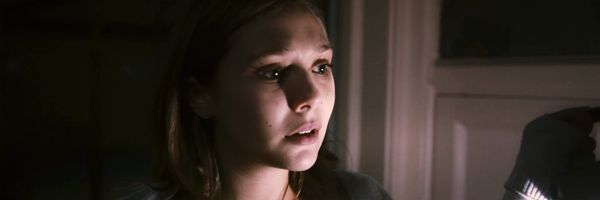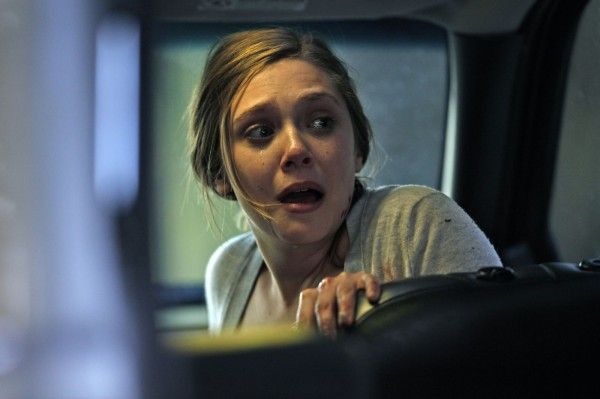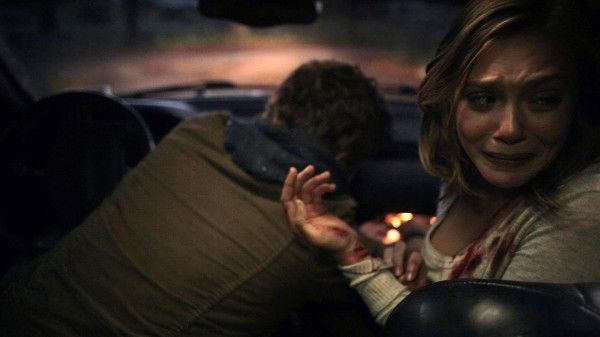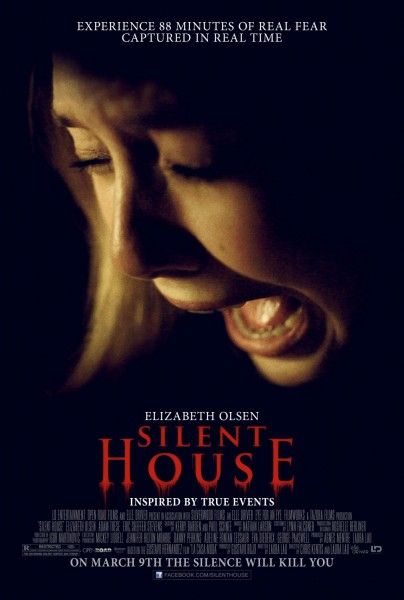An interesting concept is all well and good, but without proper execution, it's worthless. The concept behind Chris Kentis and Laura Lau's horror film Silent House is to look like one unbroken, 88-minute shot (in reality, there are ten hidden cuts). Theoretically, it's a great approach to horror film. If you don't break the shot, then you don't break the tension, and we never leave the side of the terrified protagonist. But Kentis and Lau completely bungle their intriguing concept through cheap scares, paper-thin characters, an irritating lead performance, and a confusing, exploitative ending.
Sarah (Elizabeth Olsen) has joined her father John (Adam Trese) and her uncle Peter (Eric Sheffer Stevens) to clean out the family's old lake house. The dilapidated home is in the process of being renovated and has no power, so the family members carry around lanterns and make small talk about mold in the walls and Sarah having to pack up her old things. After a bizarre meeting with a supposed childhood friend (Julia Taylor Ross) and having her uncle storm out in a huff after having a tiff with his brother, Sarah begins to hear footsteps upstairs. She promptly begins to freak the hell out, the house starts making louder thumps, her father disappears, and she starts scrambling around the house trying to escape, but mostly crying, whimpering, and hiding from intruders who may or may not be supernatural.
The technical time constraint of filming for 88 minutes straight forces the story to rush through vital plot and character development. We barely know Sarah, John, and Peter, and so we couldn't really care less what happens to them. Silent House could possibly get away with short-changing John and Peter, but the camera never leaves Sarah's side, and we need to sympathize with her in order to share her terror. Instead, she's nothing but a scream queen and the film can't wait to make her shriek. Rather than start with a slow build to ramp up the terror, Sarah is scared out of her mind about twenty minutes into the film and never lets up. Any hints of mystery are always drowned out by her laughably shrill reactions.
Olsen's performance in Silent House is the polar opposite of her extraordinary work in Martha Marcy May Marlene. Instead of nuance, poise, and shading she showed in that film, her performance in Silent House isn't much more than weeping and wailing. Granted, she has almost no character to work with, but Olsen has to know she's giving a one-note performance that's unworthy of her talent. It must be exhausting to act that terrified for an hour, and it's exhausting to watch but not very entertaining. At best, we get unintentional laughs from watching Sarah keep running under tables and making silent screams.
But Sarah is just another aspect of a film that clearly hasn't been thought out or pushed to reach its full potential. The movie opens with a graceful-yet-ominous overhead tracking shot of Sarah. The camera softly floats down to the ground, which is the last time there will be any semblance of control in the cinematography. For the remaining 87 minutes, the camera may as well be shoulder-mounted to Olsen as it jerks around and gives the audience motion sickness. A hand-held camera is the only way to accomplish the unbroken shot, but it's no excuse for ruining the scares. Every time something scary happens, the camera shakes wildly and we're wondering why Sarah's fleeing from a blur.
Not content to stick us with an irritating protagonist and haphazard cinematography, Silent House has to deliver one final insult to its annoyed audience. The film's ending is predictable, poorly-executed, and ironically exploitative. The resolution almost feels accusatory as the filmmakers scold us for being scared of the wrong things, which is a little funny since the movie hasn't scared anyone at all. As another slap in the face, the ending showcases one of the few moments where the filmmakers were able to make the audience stop and wonder, "How did they pull off that visual effect? How did they pull off that quick disappearance?"
Silent House is one missed opportunity after another where the sole focus is making the camera keep pace with Sarah and using her POV at the worst moments. Rather than take the effort to weave in some memorable imagery and inventive practical effects throughout, Kentis and Lau coast on their concept and assume their work is done. But rather than having the audience crave a break from the terror, all we really want is a break from the tedium.
Rating: D




